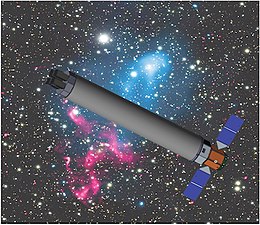 Artist concept of the Arcus satellite on orbit. | |
| Mission type | X-ray space observatory |
|---|---|
| Operator | NASA |
| Website | www |
| Mission duration | 2–5 years (proposed) |
| Spacecraft properties | |
| Bus | LEOStar-2 S/C [1] |
| Manufacturer | Orbital ATK [2] |
| BOL mass | ≈1,142 kg (2,518 lb) [1] |
| Power | 405 W [1] |
| Start of mission | |
| Launch date | 2023 (proposed) [3] |
| Main telescope | |
| Focal length | 12 m (39 ft) [1] |
| Collecting area | 500 cm2 (78 sq in) [1] |
| Wavelengths | X-ray |
Arcus is a proposed X-ray space observatory proposed to NASA's Explorer program, Medium Explorer (MIDEX) class.
The Arcus mission would study galaxies and galaxy clusters using high-resolution X-ray spectroscopy to characterize the interactions between these objects and the diffuse hot gas that permeates them. The Principal investigator is Randall Smith at the Smithsonian Astrophysical Observatory in Cambridge, Massachusetts; the project has significant contributions from the Massachusetts Institute of Technology, cosine Measurement Systems (Sassenheim, [4] Netherlands), [5] [6] Penn State, and the Max Planck Institute for Extraterrestrial Physics. [2] [3]
